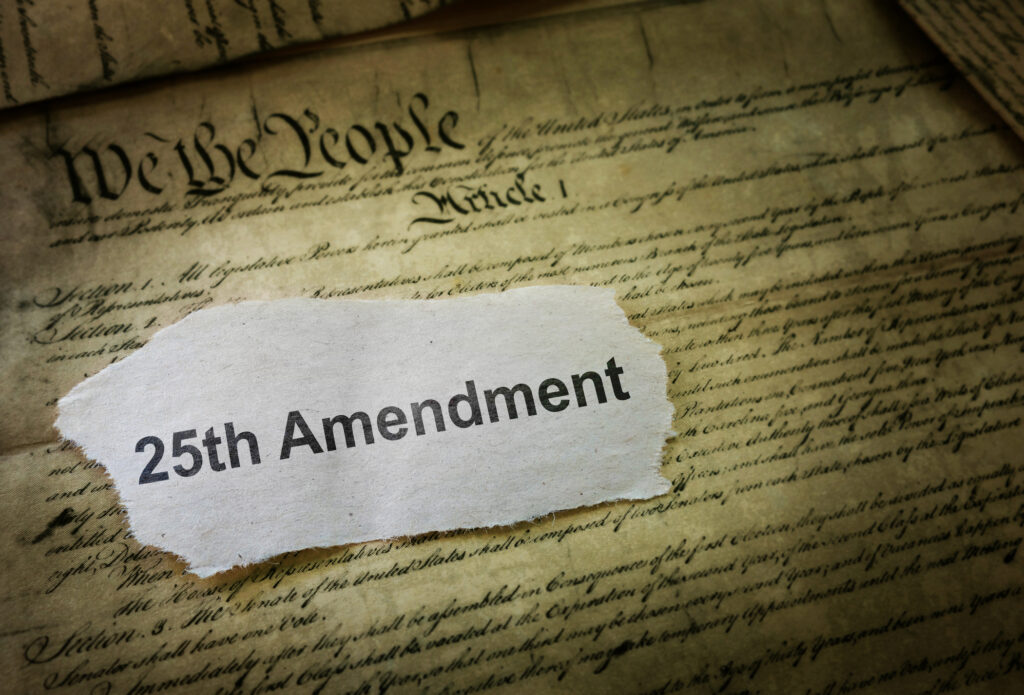Written By: Christopher B. Dolan and Matthew D. Gramly
This week’s question comes from Donald in Washington, D.C. who asks: Following the January 6th riots in Washington D.C and the storming and occupation of the Capitol Building by domestic terrorists egged on by President Trump, I’m hearing many people call for the invocation of the 25th Amendment. What is it, what does it do, and how does it work?
Dear Donald: Thank you for your timely question. The 25th Amendment to the Constitution of the United States, commonly referred to as the Disability Clause, provides a framework to remove a sitting President from office before the end of their term, either willingly or unwillingly. It defines when and how the Vice President becomes President if a sitting President dies while in office, resigns or is removed from office.
The Amendment was drafted in 1965 in the wake of the assassination of President John F. Kennedy. Following Kennedy’s assassination, Lyndon B. Johnson was sworn in as the next President on Air Force One in Dallas, Texas. However, there needed to be a more formal set of Constitutional guidelines in place to govern such circumstances. The draft amendment was submitted to the states by Congress for approval and was formally adopted as an amendment to the Constitution on February 10, 1967.
There are four sections within the 25th Amendment. The first three sections address what is to happen in the case of the President’s death, or a resignation or incapacitation which the President acknowledges. The fourth section addresses the incapacitation of the President that the President is unwilling or unable to acknowledge, essentially removing a President from office against his will. It would seem that for purposes of this discussion it is the fourth section that applies most directly to current circumstances. The bipartisan allegation has been made that President Trump purposefully instigated his supporters to violently take over the Capitol Building in Washington, D.C., that he aided and abetted a terrorist attack on the United States, that he encouraged it while it was happening, and that this is evidence of his unfitness for office. Many people are saying that he is a clear and present danger to the United States and must be removed from office immediately.
The fourth section of the 25th Amendment provides the framework and process by which this could be accomplished. Theoretically the fourth section allows the Vice President, along with a simple majority of members of the President’s Cabinet (Secretary of State, Secretary of Defense, Secretary of Labor, etc.) to make the determination on their own that the sitting President is in some manner disabled to the point of being no longer capable of performing the functions of the office in a competent manner. However, it is important to note that it has never been enacted against a sitting President’s will. There is no precedent in American history for what our nation currently faces: the possibility of removing a sitting President from office who is conscious, otherwise fully ambulatory and does not want to go.
The 25th Amendment has only been invoked a few times in our nation’s history. Most recently it was called upon for such a mundane thing as President George W. Bush being under sedation for a colonoscopy. The powers of the office, if not the title, were thereby transferred to then Vice President Dick Cheney for a few short hours. The 25th Amendment was NOT enacted, however, in 1981 following an assassination attempt on President Ronald Reagan, who was under sedation and incapacitated for a much longer period of time than one would be for a routine colonoscopy. President Reagan’s doctors later stated that the situation had most definitely called for the enactment of the 25th Amendment’s provisions for a period of several days.
It is also important to note that similarly with the concept of whether a sitting President can issue a self-pardon for federal crimes, the fourth section of the 25th Amendment, removing an otherwise healthy sitting President from office against his will, has never been tested in the courts. It simply never has been attempted. However, the fourth section of the Amendment DOES provide a Constitutional framework for doing so.
The first paragraph of Section Four reads as follows,
“Whenever the Vice President and a majority of either the principal officers of the executive departments or of such other body as Congress may by law provide, transmit to the President pro tempore of the Senate and the Speaker of the House of Representatives their written declaration that the President is unable to discharge the powers and duties of his office, the Vice President shall immediately assume the powers and duties of the office as Acting President.”
This single sentence provides for the Constitutional removal of the President of the United States of America from office against his will.
It would require what would essentially be a letter signed by Vice President Mike Pence and 11 or 12 members of the President’s Cabinet attesting under penalty of perjury that President Donald Trump is no longer capable of performing the duties of the Office of the President. They would deliver a copy to the Senate and a copy to House Speaker Nancy Pelosi. Thereafter Mike Pence would be immediately sworn in as Acting President, thus ending the Presidency of Donald. J. Trump. Regardless of whether or not the provisions of the 25th Amendment are enacted in these current circumstances, at noon on January 20th Joseph R. Biden and Kamala D. Harris will be sworn in as President and Vice President, respectively.










